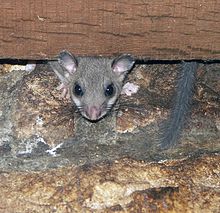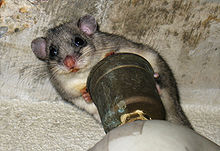Dormouse
| Dormouse | ||||||||||||
|---|---|---|---|---|---|---|---|---|---|---|---|---|

Dormouse ( Glis glis ) |
||||||||||||
| Systematics | ||||||||||||
|
||||||||||||
| Scientific name of the genus | ||||||||||||
| Glis | ||||||||||||
| Brisson , 1762 | ||||||||||||
| Scientific name of the species | ||||||||||||
| Glis glis | ||||||||||||
| ( Linnaeus , 1766) |
The dormouse ( Glis glis ) is an outwardly mouse-like , nocturnal rodent from the family of the dormouse (Gliridae). The shape of this animal is reminiscent of squirrels and gray squirrels . But the dormouse is much smaller, has large, black eyes, rounded ears and a less bushy tail. The face has no drawings, but long whiskers. The paws of these animals are always slightly damp and are made in such a way that dormice can climb trees and walls without any problems. The animals live up to 9 years old and weigh between 70 and 160 g. The head-trunk length is 13 to 18 cm, plus the 11 to 15 cm long tail. The dormouse was animal of the year 2004 in Germany .

Naming
Allegedly it got its name because of its seven months of hibernation , but this rest period often lasts from the beginning of September to the beginning of May of the next year and thus significantly longer than seven months. In popular belief , the dormouse is associated with the seven sleepers and, depending on the mood, interpreted as either good house spirits and protectors of the house residents or a bad omen .
habitat
These animals can be found in deciduous forests or large gardens (ideally: orchards ) from continental Europe to Persia . The dormouse likes to look for sleeping quarters in tree holes , birdhouses and under the roofs of houses. While he slept there during the day, he used to run around at night and could make so much noise that it could be assigned to an adult, such as a burglar, and not to such a small animal.
For the first time in 2015 , the Naturschutzbund - BUND Group Leverkusen installed radio cameras in titmouse nesting boxes that wild dormice use as sleeping quarters. This enabled a live stream on the Internet to show the life of the dormouse inside their home, including the hatching and rearing of the young. This project has been repeated annually since then.
food
In autumn, particularly high-fat foods are preferred for eating the “winter fat”. These include beechnuts , acorns , hazelnuts , chestnuts and other seeds that are high in oil and fat. In the summer months, dormouse feed on buds, bark, fruits and mushrooms . Occasionally the diet is supplemented with insects , bird eggs or small birds .
Reproduction
The mating season begins one month after waking up from the long hibernation , whereby the actual reproduction in this mammal is basically only controlled by the male's ability to fertilize, which is not always given. In years with a good food supply in autumn alone, the testicles of the males are already significantly enlarged in spring , which is associated with an actual fertility. How this predictive control comes about in the dormouse has not yet been scientifically clarified. Sometimes the mating season lasts until the end of August. After a gestation period of 30 to 32 days, four to six, rarely up to eleven, blind young are usually born between the beginning of August and mid-September. After 21 to 32 days, they open their eyes and then begin to eat solid food until the beginning of hibernation. In this short phase they depend on a very good supply of food to survive.
Hibernation
For its hibernation, the dormouse usually digs about 30 to 100 cm deep into the earth in September to be protected from frost. In his cave in the earth, which is not much larger than himself, he adopts a spherical posture in order to reduce his heat emission as best as possible. By the beginning of May at the latest - that is, after up to eight months - it digs itself up again after several hours of waking up. In order to survive the long period in the earth, the dormouse feeds on its fat reserves, which it has eaten up over the summer, and its heart rate decreases from around 300 to 5 beats per minute. So it is also possible for him to get by with the low oxygen supply in his cave. His body temperature drops to five degrees Celsius, which is roughly the temperature of the floor. To avoid cell death at lower temperatures, hibernation is interrupted by short warm-up and wake-up phases. However, this does not happen in a certain rhythm , but only once or twice.
In the vicinity of human settlements it often happens that the dormouse looks for a frost-protected place in a building to hibernate. The duration of hibernation can then be significantly reduced, depending on the temperature conditions.
Threats
The predators include martens , house cats and larger owls . Long winters can cause great damage to the population . Because of its threat, the dormouse was named Animal of the Year in Germany in 2004 by the German Wildlife Protection Association. The IUCN classifies the dormouse as "not endangered".
Dormouse and humans
In the Roman kitchen , since around the end of the republic, dormice were eaten, which were raised in special enclosures (glirarium, similar to today's hamster cages) and then fattened in dark terracotta vessels ready for slaughter. The animals were then drawn off and were mainly served in a baked or boiled preparation, usually as a snack or as an intermediate course, probably because of the low nutritional value and the high price, mainly in well-off households.
The consumption of dormice was still common in later times, for example in Slovenia , where they are considered a rare specialty and catching dormice with live traps is a rural folk tradition. The European and medieval consumption of dormice as well as the use of their fat for medicinal purposes have been documented since the 13th century. They were also increasingly hunted seasonally for food supplements or in times of need.
The term used in the English language edible dormouse (literally, edible dormouse ') suggests there also point to the previous consumption of dormice.
The consumption of the dormouse is a tradition in Italy , especially in Lombardy and Calabria . However, this is currently not legal. Hunting, fattening and consumption are prohibited because the animal is protected there.
Trivia
The Schläferskopf , a mountain in the Taunus near Wiesbaden , is named after the dormice who lived there.
literature
- Mary Ellen Holden-Musser, R. Juškaitis, GM Musser: Fat Dormouse - Glis glis. In: Don E. Wilson, TE Lacher, Jr., Russell A. Mittermeier (Eds.): Handbook of the Mammals of the World: Lagomorphs and Rodents 1. (HMW, Volume 6) Lynx Edicions, Barcelona 2016, p. 880 -881, ISBN 978-84-941892-3-4 .
- Albert Vigoleis Thelen : Glis-Glis. Dormouse, dormouse, book mouse. 2nd Edition. Olms, Hildesheim 2001, ISBN 3-487-08432-5 .
- Arnold Freiherr von Vietinghoff-Riesch : The dormouse (Glis glis L.). Fischer, Jena 1960 ( Monographs of Wild Mammals. Volume 14).
Web links
- Glis glis in the endangered Red List species the IUCN 2008. Posted by: G. Amori u. a., 2008. Retrieved January 1, 2009.
- Dormouse and other dormouse at www.glirarium.org
- Siebenschläfer at www.markuskappeler.ch
- Little goblins - after eight months of hibernation, the dormice are perky again on the website of the Naturschutzbund Germany
- Project dormouse - what are dormice? on the website of NABU Leverkusen
Individual evidence
- ^ Siebenschläfer-TV: Pictures of a birth , accessed on March 10, 2018.
- ^ Project dormouse: dormouse live webcam , accessed on March 6, 2019.
- ↑ The awakening of the dormouse , video recordings of the awakening phase after hibernation.
- ↑ Edmond Saglio , “Glirarium” . In: Daremberg and Saglio, Dictionnaire des Antiquités Grecques et Romaines , Tome II (Volume 2), p. 1613, Librairie Hachette et Cie., Paris, 1877–1919.
- ↑ Miha Krofel: Confirmed presence of territorial groups of golden jackals ( Canis aureus ) in Slovenia (PDF; 134 kB). Natura Sloveniae: Journal of Field Biology 11 (1), 2009; Pp. 65-68. Accessed January 18, 2011.
- ↑ Haberl, Werner. "Dormouse Hunting in Slovenian Tradition" . Dormouse Culture, Tradition & Myths. 2007. October 3, 2007.
- ↑ Sina Schreiner The outlook as a reward ( memento from June 26, 2013 in the web archive archive.today ) ( Wiesbadener Kurier ), from July 29, 2010, accessed on March 10, 2018, from wiesbadener-tagblatt.de







